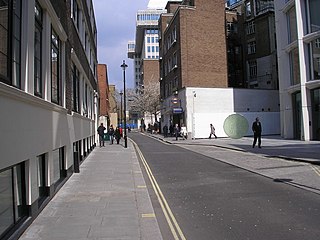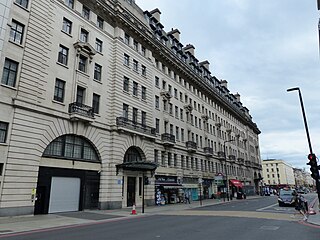
Harold Adrian Russell "Kim" Philby was a British intelligence officer and a spy for the Soviet Union. In 1963, he was revealed to be a member of the Cambridge Five, a spy ring which had divulged British secrets to the Soviets during World War II and in the early stages of the Cold War. Of the five, Philby is believed to have been most successful in providing secret information to the Soviets.

A mansion is a large dwelling house. The word itself derives through Old French from the Latin word mansio "dwelling", an abstract noun derived from the verb manere "to dwell". The English word manse originally defined a property large enough for the parish priest to maintain himself, but a mansion is no longer self-sustaining in this way. Manor comes from the same root—territorial holdings granted to a lord who would "remain" there.

Carlton House was a mansion in Westminster, best known as the town residence of King George IV. It faced the south side of Pall Mall, and its gardens abutted St James's Park in the St James's district of London. The location of the house, now replaced by Carlton House Terrace, was a main reason for the creation of John Nash's ceremonial route from St James's to Regent's Park via Regent Street, Portland Place and Park Square: Lower Regent Street and Waterloo Place were originally laid out to form the approach to its front entrance.

Cambridge House is a Grade I listed former townhouse in central London, England. It sits on the northern side of Piccadilly at number 94, in the fashionable district of Mayfair. As of 2021, the property is being converted into a luxury hotel and seven residences.

Broadway is a street in the City of Westminster in London that runs between Petty France, Queen Anne's Gate, Carteret Street and Tothill Street in the north and Victoria Street in the south. It is joined on the west side by St Ermin's Hill and Caxton Street, and on the east side by Dacre Street.

The House of St Barnabas, at 1 Greek Street, Soho, is a Grade I Listed Georgian building in London notable for its rococo plasterwork interiors and for other architectural features.
Edwin Thomas Hall (1851–1923) was a British architect known primarily for the design of the Liberty & Co. department store, the Old Library at Dulwich College (1902–03) and various hospitals. He was the brother of the architect George Alfred Hall and father of Edwin Stanley Hall, also a noted architect.

Caxton Hall is a building on the corner of Caxton Street and Palmer Street, in Westminster, London, England. It is a Grade II listed building primarily noted for its historical associations. It hosted many mainstream and fringe political and artistic events and after the Second World War was the most popular register office used by high society and celebrities who required a civil marriage.

The Humble Oil Building, is a historic office building, designed in the Italian Renaissance architecture style, located at 1212 Main Street in Houston, Texas and listed on the National Register of Historic Places. It was constructed by Humble Oil and Refining Company in 1921. The tower section was added on to the building in 1936. The building complex served as the company headquarters for Humble Oil and Refining Company from 1921 until 1963, when the company moved into what is now the ExxonMobil Building at 800 Bell Street. In 2003, the building complex was renovated for use as a combination hotel and apartments, the apartment section was converted to additional hotel rooms in 2015.

Le V is a hotel and apartment complex in Montreal, Quebec, Canada. It is located on René Lévesque Boulevard West between Bleury Street and Anderson Street in Downtown Montreal.

The Hôtel de Saint-Aignan, originally the Hôtel d'Avaux, is a 17th-century hôtel particulier, located at 71 Rue de Temple, in the 3rd arrondissement and the Marais district of Paris. It was constructed 1644–1650 to the designs of the architect Pierre Le Muet for Cardinal Mazarin's Superintendent of Finances, Claude de Mesmes, Comte d'Avaux, and later purchased by Paul de Beauvilliers, Duc de Saint-Aignan, who added the grand staircase. It is now the home of the Musée d'Art et d'Histoire du Judaïsme.

The Secret Intelligence Service (SIS), commonly known as MI6, is the foreign intelligence service of the United Kingdom, tasked mainly with the covert overseas collection and analysis of human intelligence in support of the UK's national security. SIS is one of the British intelligence agencies and the Chief of the Secret Intelligence Service ("C") is directly accountable to the Foreign Secretary.

General Patrick Hurley opened the Ambassador Hotel in 1929, intending it to be a luxury "extended stay" residence for Tulsa businessmen, who were building mansions that were not yet ready for occupancy. Hurley never stayed in the hotel he founded. He moved to Washington, D. C. in March 1929, after President Herbert Hoover chose him to be Secretary of War, after the death of the previous Secretary, who died in December 1929. Hurley never returned to Tulsa.
Autograph Collection is a group of independent upper-upscale to luxury hotels within the Marriott International portfolio. The properties are independently owned and operated under the Autograph Collection name.

Palmer Street is a street in the City of Westminster in London that runs between Petty France in the north and Victoria Street in the south. It is crossed by Caxton Street and Butler Place. The lower half of Palmer Street, below Caxton Street, is pedestrianised.

Caxton Street is a street in the City of Westminster in London that runs between Buckingham Gate in the west and Broadway in the east. It is joined on the north side by Vandon Street and crossed by Palmer Street.

Westminster City Hall is a municipal building in Victoria Street in Westminster, London. It is the headquarters of Westminster City Council.

Chiltern Court, Baker Street, London, is a large block of flats at the street's northern end, facing Regent's Park and Marylebone Road. It was built between 1927 and 1929 above Baker Street tube station by the Metropolitan Railway.





















